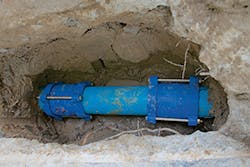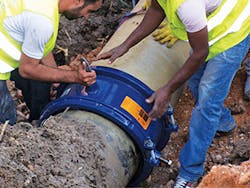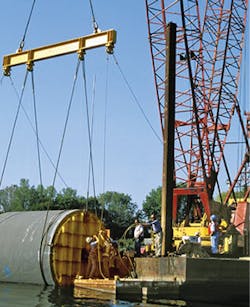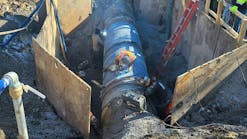When it comes to pipes, when it is appropriate to repair them? And, when is it the right time to replace them?
Certainly the nation’s aging infrastructure—as well as a growing population requiring larger pipes to move more water—is bringing this question to the fore more frequently.
In addressing when to repair or replace pipe, Doug Riseden, technical support manager for Krausz USA, notes that US municipalities and water utilities are struggling to make upgrades due to budgetary restraints, even as their water and wastewater infrastructure is deteriorating.
“In the meantime, utilities make pipe repairs until a long-term solution can be financed and implemented,” he adds. “The question of when it makes the most financial sense to replace pipe versus repairing it is not a simple one to answer. The short-term costs of repairing pipe may seem like an attractive option to keep costs low, but at a certain point, repeated repairs aren’t economical.”
Determining whether to repair or replace pipe requires recording and analyzing data and costs, and close communication among customers, engineers, contractors, inspectors, and the utility, Riseden points out, adding that while that is “hard work, the long-term benefit of reliable service will last for decades.”
A well-crafted plan ensures no surprises with contractors and engineers who will “walk away happy and the utility and customers should have a well-done project,” he adds.
Riseden notes three factors to consider in making the decision to repair versus replace.
One is cost. “At a certain point, the cost involved in making repeated repairs outweighs the cost to replace the pipe,” he points out. “This includes the cost of parts and expenses involved in closing up the work area once the repair is completed. If utility crews are repeatedly visiting the same section of pipe, this is the first clue that the pipe may need to be replaced.”
While a repair can solve a problem in the short term, there could be higher costs and service interruptions in the long term, Riseden adds.
The second factor: customer complaints. “The reality is that customers can dictate when and what kind of response a utility will take when water or wastewater problems arise in their neighborhood,” he says. “If service to homes and businesses is not reliable, customers are going to expect a solution that is dependable and minimizes interruption of their service.”
Data is a third factor. “It’s impossible to make an informed choice that could involve hundreds of thousands of dollars without useful data,” says Riseden. “By keeping good records, carefully examining repair data, and noticing trends, water utilities can make sound decisions about whether to repair or replace pipe.”
It’s never too late to start gathering data, Riseden points out. “Develop a system where information can be stored and easily recalled, as data is only as good as it can be accessed,” he says. “In the absence of data from the field, residences and businesses in the neighborhood can help give information on the history of water and wastewater pipe repairs in the area.”
Riseden points out that whenever repairs are being made, there are six questions to ask to help gather information for future decisions on pipe repair or replacement: who, what, when, where, why, and how?
- Who was making the repair? Who was there, and who did what?
- What was the issue? What actions were taken to make the repair?
- When was the repair made? Be accurate with day, date, and time.
- Where was the repair?
- How many times have crews been to this same location or close by?
- Why is the pipe breaking? Was the break due to a one-time incident, such as a gas company boring into the ground and hitting the pipe, or is the cause the same each time?
Factors that can be considered are external forces such as ground movement, trains, or heavy traffic. How was the repair made? What parts and equipment were used to make the repair? How much did they cost? Were quality parts and good repair techniques used to fix the pipe?
These questions are meant to be addressed each time a repair is made, says Riseden, adding that it helps to detect trends and makes it possible to predict how likely future repairs will be needed.
After reviewing the data and the costs involved, utilities can determine whether to move forward with replacing the pipe, he adds.
Ensuring new pipe installations are done properly, while keeping the project on schedule and on budget, starts first with forming a strong construction committee that can supervise and review the project from start to finish, says Riseden.
For public utilities, that committee should include at least one municipal council member, whose involvement is critical to communicating updates to the rest of council, he says. Other members should include the municipality’s finance officer, the utility’s lead engineer and assistant, the public works director and assistant, the project inspector—who might be supplied by the engineer—and a customer.
“Bringing together the right people at the beginning of the project is especially critical so that everyone is on board with the plan,” notes Riseden. “Follow-up meetings should also occur whenever there is a change to the plan. It’s also a good idea to use e-mail, Skype, and other communication tools to keep everyone in the loop. Remember to be in contact with media and local officials, such as police, so the public at large can be aware of what is happening before and during construction.”
It’s also critical to stay in close contact with public works, engineers, and inspectors, he adds.
“Public works or your utility should be the lead on your project since their crews will be tasked with maintaining the finished product,” says Riseden. “Ensure that they review the site by physically going out and walking around it.”
That includes taking photographs and video before construction starts to help manage potential claims that could arise.
“This activity should continue along with daily written reports, especially when changes are made to the original plan,” he adds.
Riseden recommends consulting with engineers as often as needed.
“You will want to have your inspector closely monitoring the project, as these people know the rules and regulations regarding installations and will help ensure the project gets approved upon completion,” he says.
Choosing good products and working with responsible contractors will ensure success, Riseden points out.
It pays to use high-quality products that are exceptionally
durable for pipe repairs or installations. The
HYMAX coupling allows for repairs to maintain a
flexible connection to prevent damage from postinstallation
ground shifts and temperature changes.
“Your utility will likely have specs on what you will accept and use in different situations,” he says. “Make sure products have a great work history with the backing of other local professionals and your engineer. It pays to use high-quality products that are exceptionally durable—even in harsh conditions—and designed to prevent future pipe damage.”
Krausz designs products such as the HYMAX to allow repairs to maintain a flexible connection and prevent damage from post-installation ground shifts and temperature changes, protecting the investment over the long term, notes Riseden.
Riseden points out, there is a difference between the “lowest responsible bidder” and the “lowest bidder.”
“The lowest bidder sometimes will leave things out of their bid and come back with a change order, which can dramatically increase the budget,” he says, adding due diligence, including references, is necessary when choosing the right contractor as to avoid surprises.
A realistic schedule is another important factor.
“Make sure the work schedule is fair to all of those involved,” says Riseden. “Customers will expect a project that adheres to a schedule that has the least effect on them. Your contractor will want a tight schedule, so they can continue to their next job and avoid penalties for not meeting the scheduled completion date. Be realistic and stay in close communication with all those involved in the project, especially when plans change during construction.”
Richard I. Mueller, P.E., president and CEO of the American Concrete Pressure Pipe Association, agrees that the question of whether to repair or replace a pipe is complicated. He adds that pipe replacement is often not due to its failure, but to a growing population that requires larger-sized pipe.
“Around 1977 to 1978, I worked on a project in northeast Dallas, Texas, where a flexible concrete pipe was improperly installed and partially crushed from end to end—four miles of 42-inch AWWA C303 concrete pipe,” says Mueller. “It appeared the pipe had been laid on rock with no bedding and had very little to no bedding under the haunches of the pipe, so throughout the pipeline length the bottom of the pipe was flattened to some degree.
“However, most of it still was watertight,” he adds. “We inspected the pipeline from end to end, determined which sections were under excessive external load based upon the pipe’s condition, and replaced those sections—maybe 600 feet in total—with PCCP, bonded the entire line, and put the line under cathodic protection.”
The pipeline continued to serve for several decades until it was finally replaced in the early 2000s, notes Mueller.
“By that time, the area had grown substantially, such that the road the pipe used to parallel was now built over the old pipe, and the need for water in the area was projected to exceed what the pipeline could provide,” he says. “New alternative supply was provided and the old damaged line was taken out of service.”
Another example is in St. Johns, New Brunswick, Canada, where Ameron had a sample pipe that served for more than 100 years before it was replaced because it was no longer large enough to supply the local area, says Mueller.
Ruggedness is a primary benefit of concrete pressure pipe, notes Mueller.
“The Portland cement mortar or concrete covering on the outside provides inherent corrosion protection and the cement or mortar lining on the inside provides a smooth, long-lasting, and corrosion resistant service,” he says. “The pipe can be designed for nearly any external load service and pressure service up to about 400 psi. It also makes an excellent jacking pipe, where pipe is installed by longitudinally forcing the pipe into a hole.”
For particular service, the design of the external capacity of concrete pressure pipe can be executed to speed up installation, says Mueller.
He explains a concrete pressure pipe can be installed using a HydroPull, a low-pressure, high-volume pump on a plug, used to engage pipe in underwater installations. The open end of the pipe is positioned near the open end of the installed pipe, and the pump is turned on to pull water out of the inside of the pipe being installed.
The pressure differential between the outside water and the inside of the pipe causes a substantial force to bring the new pipe “home” and get it properly engaged to the already laid pipe, says Mueller.
“This system has been used in many installations and recently was used on pipe installed in Lake Mead for a new, deeper supply line for Las Vegas,” he adds.
Other areas where concrete pressure pipe has been used for rehabilitation are sewers, says Mueller.
The City of Los Angeles had several large sewers relined with concrete pressure pipe that used T-Lock lining—a PVC material with anchors on the back of the sheet—says Mueller.
“When the pipe is made, the concrete is cast around the anchors, which hold the PVC in place,” he says. “After the pipe with the lining is in its final position, the PVC lining between the two pieces is melted together to form a continuous protection against the acid, which forms above the sewage flow.”
Without the T-Lock, the concrete is attached by the acid and will eventually fail, Mueller adds. With the T-Lock, Los Angeles has had more than 60 years of optimal service, with no end to the service in sight.
Concrete pressure pipe installed using a HydroPull. This device is a low-pressure, high-volume pump on a plug, and is used to engage pipe in underwater installations.
According to the Plastics Pipe Institute (PPI), pipe selection for replacement or rehabilitation needs to be based on best practices, including specifications, design, installation, and inspection that accounts for a 100-year design life, life cycle cost, water loss, failure rate, and asset management.
A system designer should evaluate operating conditions, service life, non-revenue water, construction methods, and proposed alignment, points out Camille George Rubeiz, P.E., FASCE, director of engineering for PPI’s municipal division.
Specifications can then be based on materials that can provide satisfactory service life at the lowest overall operating cost, which is a combination of installed cost and future maintenance cost, Rubeiz adds.
“If the material decision is solely based on the purchased price of the pipe, however, then money is being wasted,” contends Rubeiz.
“The project cost analysis needs to include the installed cost and performance,” he adds. “On a typical pipeline project, pipe cost is about 15% of the total job costs associated with installation. Decisions based solely on purchase price represent poor engineering and business practice and is alarming, especially when the water industry ranked water infrastructure and capital costs and availability of funds among the top concerns.”
Rubeiz contends when installers and designers “follow the book, there should be no issues. All conditions need to be considered at design. There shouldn’t be shortcuts on something you want to last more than a century.”
While the availability of funds is essential, agencies need to consider the total cost and performance to ensure proper use of funds and proper selection of materials that have at least a 100-year design life and a leak-free system, says Rubeiz.
The American Water Works Association (AWWA) recently adopted the HDPE pipe distribution and transmission standard C906, giving designers and utilities more information in choosing appropriate material specifications, he says.
Municipalities in earthquake-prone areas should consider HDPE because of its flexibility and ductility, says Rubeiz.
According to a report by the Water Research Foundation that studied the implications of recent earthquakes on US water utilities, HDPE capably withstood tremendous seismic activity, he notes.
The study states that in the 2010 Chile earthquake, while the rest of the water system suffered thousands of damaged pipes, no HDPE pipe was damaged. The report recommends HDPE pipe for common distribution pipes and service laterals in high seismic zones.
One of the primary advantages of HDPE is its ability to “shed” stresses, which allows the material to resist failures, Rubeiz says.
“This is a major advantage over rigid materials when considering the survivability of the system during regular operations and after natural disasters such as earthquakes, hurricanes, and tsunamis,” he adds.
“Also, with proper tooling and experienced operators, high-quality fusion joints are prepared per ASTM F2620 and provide a self-restraint, leak-free system and eliminates kickers or anchors associated with non-self-restraining materials and systems.”
Heat fusing sections of PE4710 HDPE pipe provides a leak-free system. Its heat-fused joints mean zero water loss, which is an important quality as worldwide water value increases, Rubeiz points out, adding the process creates an unbreakable bond and a joint as strong as the rest of the pipe.
Service taps can be connected by fusion methods, providing yet another leak-free connection requiring minimal future maintenance, says Rubeiz, adding the ASTM and the PPI publish pipe fusion standards, such as ASTM F2620, as well as guidelines on how to train municipal operators on fusion.
Long continuous segments of HDPE pipe can be installed with horizontal directional drilling as per ASTM F1962, which is proven to reduce installed cost, he says.
“When compared to open cut, and when feasible, horizontal directional drilling and trenching will significantly minimize pavement replacement, surface improvement repair, hauling of excavated material, importing back fill material, cost of traffic control, and interruption to residents and business,” says Rubeiz.
HDPE is available in sizes of 1/2-inch up to 65 inches, covering everything from service lines to distribution and transmission pipes.
Numerous life prediction studies conducted on HDPE in most environmental situations prevalent within US water systems demonstrate HDPE materials are predicted to last a minimum of 100 years, says Rubeiz.
PE 4710 is the highest performance classification of HDPE piping material for water applications.
“PE 4710 compounds offer utilities and designers a greater level of performance,” says Rubeiz. “This translates to the ability to utilize HDPE with increased flow capacities, plus increased resistance to surge pressure, fatigue, and slow crack growth when compared to previous PE 3608 compounds. The updated ANSI/AWWA C906-15 standard includes PE 4710 for sizes up to 65 inches and recognizes the increased durability and reliability of HDPE pressure pipe used in water systems.”
The C906-15 update includes enhanced performance HDPE resins—PE4710—that improve the durability and reliability of HDPE pressure pipe used in municipal and industrial water and wastewater systems, says Rubeiz.
According to Rubeiz, many engineers select the pipe’s pressure class based on the system’s working pressure and on the pipe’s static hoop stress capability.
“To simplify these preliminary calculations, eTrenchless Group developed and maintains a web-based calculator called PPI PACE. The free program allows users to complete pressure pipe designs, including water distribution lines, transmission main systems, and force mains, in accordance with existing AWWA and ASTM published standards.”
PPI PACE compares HDPE, PVC, and ductile iron pipe using AWWA C900, AWWA C901, AWWA C905, AWWA C906, C150/151, along with AWWA manuals such as M23, M55, and M41.
PPI PACE also contains extensive information on the selection of design parameters and typical input valves for all three major materials used in water systems.
Rubeiz points out, the AWWA defines pressure class differently for all three of the different materials.
“For example, the pressure class for PVC and ductile iron pipe is not equivalent or relevant for HDPE pipe,” he says. “For example, to meet the design requirements of 160 psi, the required flow velocities, and fatigue life, PVC pipe with a DR 14 and pressure rating of 305 psi would be required, while PE 4710 pipe with a DR 13.5 and rated at 160 psi met the project design requirements.
“It would be common for a PVC pipe with DR 25 (PC165) or DR 18 (PC 235) to be specified to satisfy the 160 psi design pressure requirement,” adds Rubeiz. “If this was done, the system would be under-designed by having a fatigue life less than 100 years. For ductile iron pipe, the fatigue life calculations are not available in AWWA C150/151 and M41.”
In one example of the use of plastic pipe, the city of Beaumont, TX, recently sought to mitigate the challenge of preventing contamination of their raw water source, while protecting the wetlands surrounding the water canal.
Beaumont’s raw water is drawn from the Neches River and transported in a canal system to its treatment facility. The levees that protect the aged canal system from infiltration have eroded, enabling intrusion from outside sources, including saltwater from hurricane season runoff.
City officials were challenged in trying to conduct construction operations in federally protected wetlands. For every acre of wetlands disturbed, seven other acres must be turned into wetlands.
They chose an offshore pipeline construction solution to eliminate the impurities traveling to the treatment plant in an effort to lower its operating cost and increase efficiency.
A dam equipped with gates that can be shut during a tidal surge was constructed to serve as a saltwater barrier. Flexible HDPE pipe is floated up a canal in Beaumont prior to submersion and installation with minimal impact.
During a tidal surge, saltwater drifts up the Neches River. The raw water harvested by the city is brackish. The canal runs parallel to the river for about 12 miles, and then travels through a pipeline under the river to a pump station.
From there, it travels 13,000 feet down the canal with the eroded levees.
Officials decided to install a 48-inch HDPE DR 32.5 pipe and pump the raw water the last 13,000 feet from the pump station to the plant.
The old canal system would provide the path the pipe would take, requiring no digging or disturbance of the wetlands.
Brystar Contracting consultant Everett Phelps had noted polyethylene is the only piping material that could have been used for the job. From a staging area in a park located near the Neches River crossing, the pipe sections were stacked.
The pipeline was fused by a butt fusion process using heat and pressure to connect polyethylene pipe end to end.
The ends of the pipe are melted with a heater, and after becoming molten, are pressed together and held until the melt cools. The resulting joint is stronger than the pipe, with no need to reinforce the joint.
As the pipe was being fused together, one-ton concrete weights were attached to it at eight-foot intervals before being pushed out into the canal. The pipe was capped on the end so it floated in the water as it was being fed one section at a time into the canal toward the treatment plant.
After all 13,000 feet of pipeline was completed, the cap was removed and the pipe filled with water and sank to the bottom of the 20-foot deep canal.
Historically, water utilities have often avoided pipeline replacement, opting for repair and rehabilitation instead, says Karen Lively, technical manager for Performance Pipe, a division of Chevron Phillips Chemical Company.
“Sometimes the decision to rehabilitate a pipe versus replace it is triggered by the availability of higher funding that is allowed for emergency repairs, compared to the capital expenditure required for installation of a new pipeline,” she says.
That’s in contrast to gas distribution utilities, which are encouraged to replace pipelines through a Distribution Integrity Management Protocol (DIMP), a process that allows for the replacement of pipe on a planned schedule when issues are identified or the infrastructure reaches the end of its useful life, she adds.
Trenchless technologies and flexible pipelines such as HDPE piping provide utilities with new options, notes Lively.
“Replacement pipelines can be installed for significantly less than traditional new pipeline installation costs, thereby reducing the difference between rehabilitation and replacement costs,” she says. “Trenchless technologies also provide benefits to water utilities, by allowing them to replace pipelines with increased capacities with minimal impact to neighborhoods and city streets.”
Today’s considerations for rehabilitation versus replacement should include several factors, notes Lively, the first being the history of the pipeline and similar types of pipelines within the utility district.
“A pattern of leaks or failures in a given pipeline or type of pipeline suggest that attempts to repair individual leaks will result in money spent on a short-term fix, while investing in a replacement pipeline would save the utility costs over the near and long-term, and greatly improve its water delivery efficiency,” she says.
Consideration should also be given to whether or not the long-term needs of the pipeline are being addressed, notes Lively.
“If it is possible that additional long-term pipeline capacity will be needed, the trenchless technique of pipe-bursting can be used to replace existing pipelines with new and larger diameter pipelines with minimal impact to the environment above ground,” she points out.
Another consideration is in regard to gasketed or conventionally joined pipelines.
“When this type of pipe is being replaced, defined amounts of leakage are expected and allowed by standard, but with properly-fused HDPE pipe joined by butt-fusion joining methods, there is zero leakage,” says Lively.
“This improves the water delivery efficiency of a utility system, which can delay having to make capital investments for new water supplies,” she adds.
Repairs are best warranted when a leak transpires due to an isolated event, says Lively.
“These generally occur from third-party damage or a single isolated event of failure,” she adds. “Isolated failures demand a repair solution.”
Where failures have occurred, the cause of the failure should be determined to the extent possible, notes Lively.
“If material or location and environmental causes are suspected, plans should be made to address those causes prior to repairing or replacing the pipeline,” she says. “Examples of failures that occur from causes related specifically to the environment of the pipeline could include soil shifts or changes that occur with seasonal changes, such as drought or freeze conditions.
“Typically, repairs that employ trenchless installation technology utilizing HDPE pipelines provide a lower-cost solution than new pipeline with traditional pipelines materials.”
Lively agrees with other industry experts that in areas subject to seismic activity, HDPE pipelines offer another significant advantage of being seismically resistant.
“If repairs are necessary in areas where substantial movement of earth or soils will occur, then HDPE pipelines are a good choice,” she points out.
HDPE piping systems “offer tremendous advantages over traditional materials and when compared from a life-cycle cost perspective is clearly a preferred choice,” says Lively. “Performance Pipe DriscoPlex HDPE piping has a long history of performance that provides both financial and environmental benefits over time.”
DriscoPlex HDPE pipe is designed for flexibility, leak-free reliability, ease of use for trenchless installation, and long life, she adds.
“It offers clean, lead-free interiors that promote efficient flow. HDPE does not rust or corrode. Because of its flexible qualities, DriscoPlex HDPE pipe is strain-resistant at the joints, able to accommodate stress from freezing content, and ideal for areas with seismic activity.”





